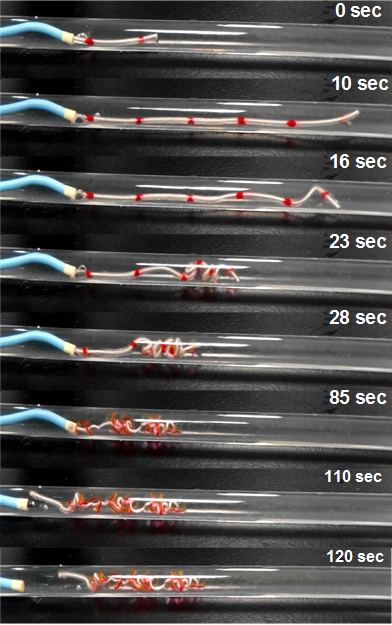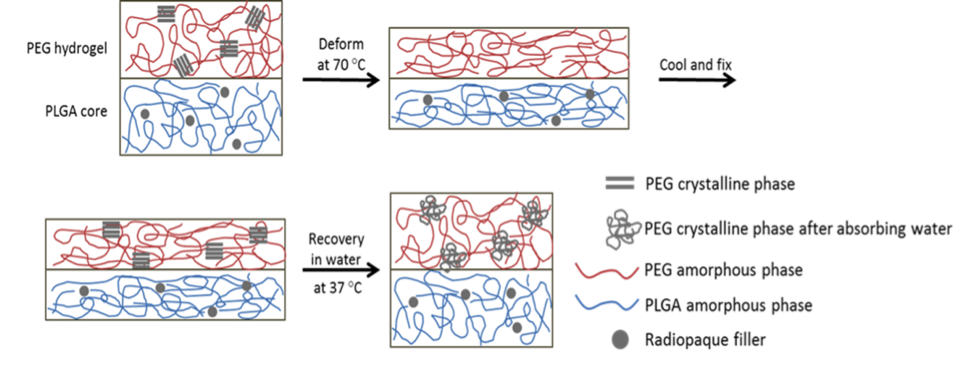Biodegradable radiopaque water responsive shape memory polymer-hydrogel composite: a device for temporary embolization therapy for liver cancer
-
1
Nanyang Technological University, Nanyang Institute of Technology in Health and Medicine, Singapore
-
2
Nanyang Technological University, Mechanical & Aerospace Engineering, Singapore
-
3
Nanyang Technological University, Materials Science & Engineering, Singapore
-
4
Singapore General Hospital, Department of Diagnostic Radiology, Singapore
Introduction: Liver cancer (Hepatocellular Carcinoma) is fifth-most common type of cancer and the second-most reason for cancer-related death worldwide and is highly prevalent in Asia [1]. Whilst the surgery is the only curative way, only 10% of primary and metastatic liver cancer patients are eligible for resection while the remaining patients can only opt for palliative treatments such as Transcatheter arterial chemoembolization (TACE) and Selective internal radiation therapy (SIRT) [2],[3]. Embolization is crucial step in the TACE or SIRT treatments for enhancing the efficacy of therapy while reducing systemic exposure. Repeat sessions at six- to twelve-weeks intervals of these treatments are recommended so the patency of the hepatic arteries needs to be restored before next treatment. With existing embolic devices the major problems are unpredictable occlusion level, uncontrollable target embolization and degradation rate.
In this work we report on fully biodegradable radiopaque solid embolic plug, which can precisely occlude the blood vessel and degrade at a predictable rate. The plug can be delivered to the target site in a low profile temporary shape by catheterization. Upon contact with the body fluid at target location it will self-expand to the fully functional shape, giving perfect occlusion in less than two minutes.
Materials and Methods: The embolic device consists of biodegradable Poly(DL-lactide-co-glycolide) (PLGA) filament coated with Poly(ethylene glycol) (PEG) hydrogel. The water induced buckling effect of the PEG hydrogel filament, synthesized using photo-crosslinking method and stretched to different deformation strains at above-melting transition temperature, was explored. Different PLGA compositions modified with the varying amount plasticizer and radiopaque fillers were extruded in filament form and were investigated in terms of their thermo-mechanical properties, degradation timeframe, the effect of programming conditions on the shape memory behaviour and the extent of radiopacity for imaging. The shape memory polymer-hydrogel composite was then fabricated using optimized formulation derived from the individual characterization results of the PLGA and PEG hydrogel. In-vitro performance of the device, in terms of occlusion rate using a custom-built peristaltic flow system and biocompatibility, was evaluated. Based on the material characterization results, the mechanism for water-responsive shape memory effect in such a polymer-hydrogel composite was elucidated.
Results: 7.5% (w/v) PEG-diacrylate hydrogel photo-crosslinked using 2% (w/w) Irgacure-2959 initiator was found to be optimum. Pre-stretched hydrogel filaments displayed deformation strain dependent water induced buckling phenomena. PEG hydrogel stretched to 500-550% uniaxial strain at 70°C exhibited faster buckling without breaking of gel. From the radiopacity and thermo-mechanical testing it was found that the PLGA formulation with 2% plasticizer and 50% bismuth oxychloride exhibited best properties. The results demonstrated that the prototypes were visible under fluoroscopy and complete vascular occlusion occurred in less than 2 minutes in-vitro.
Conclusion: In conclusion, the developed embolic plug possesses promising characteristics crucial to the temporary vascular embolization for liver cancer treatment.

Figure1: In-vitro embolization by the developed embolic plug

Figure2: Water-responsive shape memory mechanism of the PLGA-PEG composite system
This project was supported by A*STAR Grant No. 132 148 0011 (Singapore).
References:
[1] Jemal A, Bray F, Center MM, Ferlay J, Ward E, Forman D. Global cancer statistics. CA: A Cancer Journal for Clinicians 2011;61:69-90.
[2] El-Serag HB, Mason AC, Key C. Trends in survival of patients with hepatocellular carcinoma between 1977 and 1996 in the United States. Hepatology 2001;33:62-5.
[3] Llovet J. Treatment of hepatocellular carcinoma. Curr Treat Options Gastro 2004;7:431-41.
Keywords:
Hydrogel,
biomedical application,
Smart material,
Biodegradable material
Conference:
10th World Biomaterials Congress, Montréal, Canada, 17 May - 22 May, 2016.
Presentation Type:
Poster
Topic:
Biomaterials for cardiovascular applications, vascular grafts and embolic devices
Citation:
Salvekar
AV,
Wong
Y,
Huang
W,
Tay
K and
Venkatraman
SS
(2016). Biodegradable radiopaque water responsive shape memory polymer-hydrogel composite: a device for temporary embolization therapy for liver cancer.
Front. Bioeng. Biotechnol.
Conference Abstract:
10th World Biomaterials Congress.
doi: 10.3389/conf.FBIOE.2016.01.01635
Copyright:
The abstracts in this collection have not been subject to any Frontiers peer review or checks, and are not endorsed by Frontiers.
They are made available through the Frontiers publishing platform as a service to conference organizers and presenters.
The copyright in the individual abstracts is owned by the author of each abstract or his/her employer unless otherwise stated.
Each abstract, as well as the collection of abstracts, are published under a Creative Commons CC-BY 4.0 (attribution) licence (https://creativecommons.org/licenses/by/4.0/) and may thus be reproduced, translated, adapted and be the subject of derivative works provided the authors and Frontiers are attributed.
For Frontiers’ terms and conditions please see https://www.frontiersin.org/legal/terms-and-conditions.
Received:
27 Mar 2016;
Published Online:
30 Mar 2016.